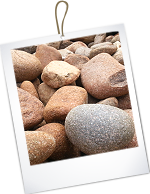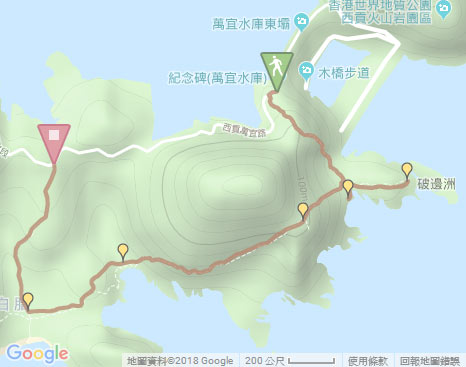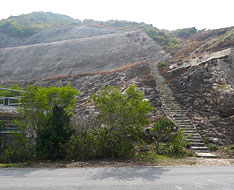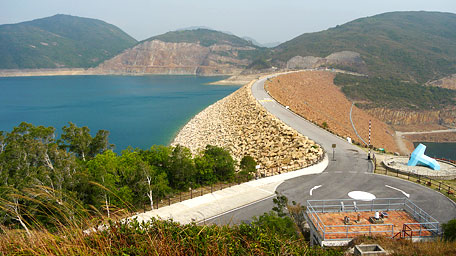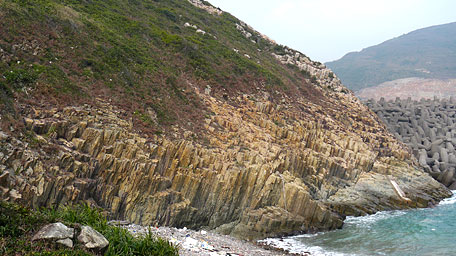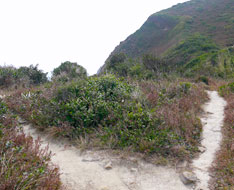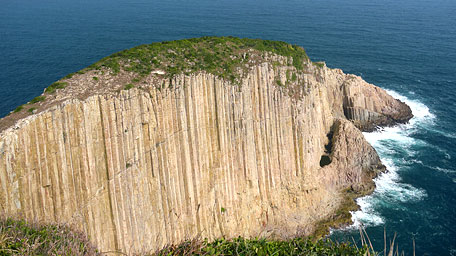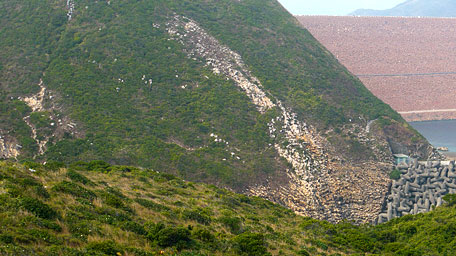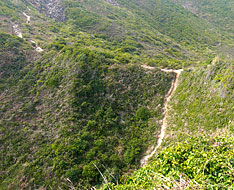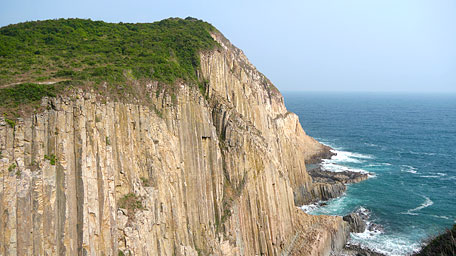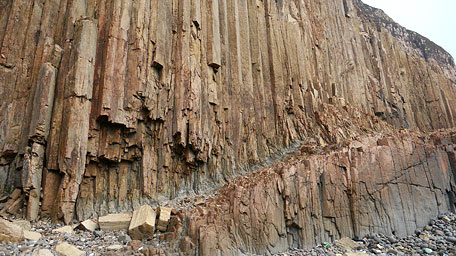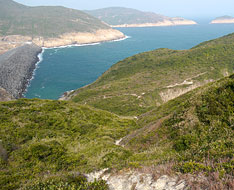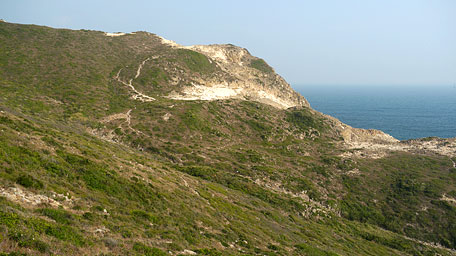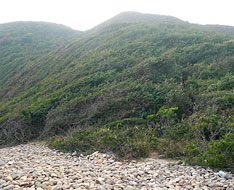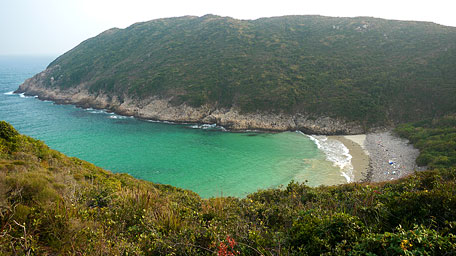
| Po Pin Chau | |
| Distance: 4.5 Km | |
| Duration: 3.5 hours | |
| Diff.: | |
| Scn.: | |
Start: Taxi, from Sai Kung to east dam of High Island Reservoir; Minibus 9A from Pak Tam Chung (Holiday only)
End: Taxi by call stations, from Man Yee Road to Sai Kung; Minibus 9A to Pak Tam Chung (Holiday only)
Part of the trail runs along the edge of cliff, through thick woods and on steep slopes that would require to clamber slightly.
1. If not to Po Pin Chau, you could directly go to Pak Lap by taking the right fork on the ridge.
2. If only going to Po Pin Chau, at the junction retrace your way to the east dam.
Due to Google changing the terms of Google Map, the daily usage rate will be limited. Please refer to the static map instead if the above map could not be displayed or used normally. I apologize for the inconvenience.
 Static Map
KML file
Static Map
KML file
The monument of East Dam
The trail starts from a flight of steps on the right slope beside the light blue monument at the east dam of High Island Reservoir. Up to a range pole, the scene of east dam could be seen. Head the trail, it joins the narrow thick wood path. At the junction facing Fa Shan, take the left path toward Po Pin Chau (Taking the right path could climb up Fa Shan). Afterward, it sharply turns downward to the valley then leads up to the junction of pathways on the ridge.
Exit: Going down to the valley toward the east dam, there is a side path along the hillside on the left that leads to the dam. It is narrow and rough, should be careful.
Po Pin Chau
Take the left path at the junction. Not far ahead, Kim Chu Wan (rolling-pebble beach) could be seen below on the right, and you could also look back a hill slope behind the pebble beach. There is a large hollow in a sharp of heart known as "Hong Kong's Heart" on the slope. Carrying on the trail along the ridge toward the east, it gives a view of the dam from another viewpoint. Beyond the shrubbery and through the edge of cliff, it comes to the end of the ridge with a concrete cross-landmark on the ground. At that moment, a huge pipe organ formed by nature is just towering on the sea in the front - Po Pin Chau.
The cape seems to be cleaved vertically as matching its vein line to fashion a sculptured spectacular nature art. In the sea wind, it is performing the sound of surf on the shore. Standing at the cliff and facing the boundless sea, I feel myself small.
Note: Along the way in part, it wind along edge of the cliff.
Kim Chu Wan (Rolling-pebble beach)
Retrace your way to the junction that have passed before, then take the left fork. Going a few steps ahead, you could see a cliffy escarpment on the left. Along the side path on the left, it leads down to Kim Chu Wan. There are many oval stones on the ground. Because the stones are scoured in a very long time by surf that make them "rolling" and produce sound of collision, the oval pebbles are finally formed on the shore. Moreover, looking up on the left, the hexagonal volcanic columns at close range which veins are orderly and distinct, are like a large rocky wall made by nature. It is because the rhyolitic volcanic rocks there are tuff feature and acidic, it appears in light colour.
Tsat Chung pebble beach
Return to the main path, then follow it to the left. After a steep climb, it comes to the open flatland at Kwun Tung Au. There is a side path climbing up Fa Shan on the right. Afterward, head the trail forward, it winds slightly down along the hillside of Fa Shan toward the west. The path is narrow, overgrown but obvious. Along the way, there are also some branches on the left leading to the coast or to the headland. Overlooking toward south, Wang Chau and Town Island (Fo Tau Fan Chau) could be seen. Along the trail, it heads to Tsat Chung pebble beach which stones seem to be those in Kim Chu Wan. The watermarks scoured from the surf layer by layer along the shore of the pebble beach are larger and more obvious.
Pak Lap
At the rear of the pebble beach, there is a side path on the right with some ribbons at the entry as a mark. Head the path uphill, it leads to the knoll where gives a beautiful view over the small beach of Pak Lap Tsai. In early spring, there are some of wild Chinese New Year Flowers in bloom on the hillside. After descending to the flatland of the valley, follow the path on the right (Heading left leads to Pak Lap Tsai). Passing through the woodland and the large lawn, it comes to Pak Lap village. Heading the concrete path to the left could go to Pak Lap Wan. Afterward, along the path to the right, it cuts through the thicket and slowly leads up till to Sai Kung Man Yee Road.![]()
Summary
It is unforgettable and admirable for the spectacular natural views on a large scale hexagonal rocky columns in a short distance especially from Po Pin Chin and the peculiar rolling-pebbles from the stone beaches. If they are destroyed, the losses are not assessable by humans.
Last Updated : 08.05.2015
Suggestions:
Other Informations:

